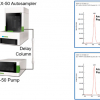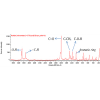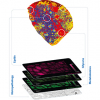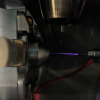Tristan Doussineau, Philippe Dugourd and Rodolphe Antoine
LASIM, University of Lyon/CNRS, 43 bd du 11 novembre 1918, F-69622 Villeurbanne, France. E-mail: tristan.doussineau@univ-lyon1.fr
Introduction
Mass is a critical property of compounds related to their quantity of matter, their inertia, as well as their energies. To measure mass one can use a scale or a balance, both of which rely on the Earth’s gravity. The balances we use today in our laboratories can even detect masses down to 10–7 g but this measurement method becomes inadequate below this limit. Indeed the mass of a molecule, for example, is so extremely small that its gravitational force is too small to be measured. This low mass can be measured by mass spectrometers that use electric or magnetic fields to separate ionised compounds according to their mass-to-charge (m/z) ratio. However, conventional mass spectrometry (MS) has limitations for weighing macro-ions with masses higher than one megadalton (1 MDa or 10–18 g).1 Above this limit, m/z spectra become unsolvable due to the fact that high mass ions may carry an unresolvable distribution of charges. Moreover, large ions may not all have exactly the same mass due to sample heterogeneity (i.e. polydispersity), residual adsorbates such as water molecules and counter ions.
One solution to overcome these limitations is to measure both the m/z ratio and the charge (z) for each ion. This single ion mass spectrometry enables one to construct a histogram of mass, yielding the true mass distribution. A convenient way to measure the charge of individual ions is to use image charge detection. A multi-charged ion in the proximity of a conductive surface impresses on it an equal and opposite image charge. In particular, if the ion travels through a conductive tube, and if the tube is long enough, the image charge is equal to the charge carried by the ion. This approach was pioneered by Shelton in 1960 for characterising multiply charged microparticles.2 Based on this concept of image current detection, charge-detection mass spectrometry (CD-MS) coupled to electrospray ionisation (ESI) was introduced by Benner and co-workers in 1995 for weighing macro-ions with masses higher than one megadalton.3 The passage of a multi-charged ion through the detection tube induces a voltage proportional to the charge of the ion and inversely proportional to the capacity of the system. The duration of this induced signal is equal to the time-of-flight (ToF) of the ion through the detector. By measuring, simultaneously, velocity and charge of individual ions, together with measuring the acceleration voltage, one can compute the mass of the ion. This allows one to extend the limit of conventional mass spectrometry towards high mass compounds, as demonstrated for large DNA strands,4 viruses,5,6 liquid droplets7 and macropolymers.8,9,10
While a single-stage MS experiment determines the mass of an analyte, tandem MS (MS/MS) can provide information on its structure. Typical MS/MS experiments involve mass selection of the ion of interest in the first MS stage and excitation of the ion followed by its dissociation and mass analysis of the resulting fragment ions in the second MS stage. MS/MS has been used to elucidate the structure of a variety of small- to medium-sized molecular ions. Due to the difficulty of detecting large size ions, using MS/MS on compounds of megadalton (MDa) molecular weight is almost an unexplored field. We recently implemented MS/MS for experiments on single electrosprayed ions from compounds of MDa molecular weight, using two charge detection devices (CDDs).9 This article briefly describes the mass spectrometry developments for mass and structural determination of nanoparticles.
Instrumentation
We developed a custom-built tandem charge detection mass spectrometer (CD-MS/MS) composed of an electrospray ionisation source (ESI) coupled to two CCDs. The ESI source generates highly charged macro-ions which are guided by an ionic train to the mass spectrometer (Figure 1). Ions are guided up to a vacuum stage chamber (10–6 mbar) which contains two identical CDDs used as a tandem mass spectrometer. Each CDD consists of a conductive tube collinear to the ion beam and connected to a field-effect transistor (JFET). The picked-up signal, given by the passage of a single ion through the detection tube, is amplified by a low-noise, charge-sensitive preamplifier and then shaped and differentiated by a home-built amplifier. The signal is recorded with a waveform digitiser card. The data are transferred to a desk-top computer where they are analysed with a custom-written user program. Calibration in charge was performed using a test capacitor that allowed a known amount of charge to be pulsed onto the pick-up tube.

The first CDD is used in a single-pass mode and allows ions to be selected and measured in the second CDD. In the single-pass mode, the signal which is picked up from each single ion composing the sample generated in the electrospray source is measured. Electrical noise limits the charge measurements in CD-MS. A root mean square (RMS) noise of ± 150–200 e is usually obtained, which imposes a low mass cut-off in CD-MS around 0.8 MDa and a precision in charge measurement of about 10–15%. In addition to the reduction of noise in the charge measurement circuit, an approach that improves the limit of the charge measurement re-measures the charge on individual ions by using an array of CDDs or an electrostatic ion trap.8,11,12 However, the moderate precision in charge measurement is largely compensated for by the high count rate that can be achieved (1000 ions s–1). From the analysis of each waveform, one can thus rapidly determine, knowing the acceleration voltage, the mass of each single ion that has travelled through the tube.
The second CDD is used as a gated electrostatic ion trap, as proposed by Benner.12 The conductive tube is surrounded by two ion mirrors (Figure 2, top) and preceded by an ion gate. Ions are selected both in m/z and z by synchronisation of the first CDD and the ion gate. Once the selected ion enters the second CDD, it can be trapped for several dozens of milliseconds. In parallel to experimental developments, we conducted SIMION ion trajectory simulations. A selected ion can be trapped between the two ion mirrors if correct voltages are applied on the electrodes of the ion mirror (Figure 2, bottom). In fact, these simulations also helped us to better understand the effects of initial kinetics energy and velocity direction angles on the trapping efficiency. During the trapping time, a continuous wave CO2 laser is used in a synchronised manner to irradiate the trapped ion through a ZnSe window.

Molecular weight determination of nanoparticles
As mentioned previously, in single-pass mode, each single electrosprayed ion passing through the detector can be measured. On this basis, mass distributions of synthetic linear MDa (from 1 MDa to 7 MDa) poly(ethylene oxide) were accurately determined.9 Averaged molar masses obtained were in good agreement with those given by the supplier and we were able to provide a polydispersity index. Our second comparative study was carried out on self-assembled amphiphilic block copolymer nano-objects with sizes ranging from 78 nm to 143 nm according to transmission electron microscopy (TEM).10 It first showed that we could push the envelope of mass spectrometry from a few MDa to gigadalton (GDa). Mass distributions were accurately histogramed allowing, for each micellar sample, the determination of the weight average molar mass (Mw), the number average molar mass (Mn) as well as the polydispersity index (Mw / Mn) according to IUPAC definitions. The versatility of the electrospray source to “make elephants fly”13 allowed us to study a large panel of nano-objects such as gold and silica nanoparticles. As examples, Figure 3 shows mass distributions obtained for nano-objects made of self-assembled amphiphilic block copolymer formed via RAFT-mediated radical emulsion polymerisation14 and a colloidal suspension of gold nanoparticles prepared by citrate reduction.15

Trapping and infrared multi-photon dissociation of single MDa ions
A single macro-ion selected in mass and charge can be trapped in the second CDD during several tens of milliseconds, which corresponds to several hundreds of oscillations. This generates an electric wavelet on the detector. The first benefit is that we can re-measure charge and time-of-flight as many times as the ion oscillates in the trap improving the z and m/z precision of CD-MS measurements by a factor that can reach ~25. During their storage time, single ions can be irradiated by the CO2 laser. The CO2 laser provides low-energy IR photons. Macro-ions can be efficiently heated by multiple absorption of IR photons (infrared multi-photon dissociation (IRMPD) experiments).16 When a trapped single ion is irradiated, drastic changes both in the trapping time and the final shape of the wavelets are observed. An example recorded for lambda phage DNA ions (of about 31 MDa in molar mass) is shown in Figure 4. We observe an induction time where almost no modification in charge occurs and then, suddenly, the loose ion continuously charges in less than 1 ms. Before it is no longer detected, the total charge of the ion is decreased by ~70 e during each round trip. This corresponds to a charge loss rate of around 1 e per microsecond. The regular charge loss as a function of time observed for lambda phage ions is in favour of sequential losses of bases accompanied by gradual unzipping of the double strand.

Conclusion
CD-MS and CD-MS/MS, working in the single-pass and multi-pass modes, respectively, provide unique data on compounds of molar mass ranging from MDa to GDa. In particular, the determination of molar mass distribution of various nano-objects has been demonstrated and this key characterisation may be extended to the so-called “nanoworld”. The implementation of an electrostatic ion trap significantly improves the precision of mass measurements and allows one to study kinetics of dissociation of large macro-ions. In particular, IRMPD was found to be a promising tool for studying unimolecular dissociation of large macroions at the single ion level.
Acknowledgements
We are grateful to the ANR for financial support of this work (ANR-08-BLAN-0110-01 and ANR-11-PDOC-032-01). The authors would like to thank Xavier Dagany, Christian Clavier, Michel Kerleroux, Marc Barbaire, Jacques Maurelli and Franck Bertorelle for their invaluable technical assistance together with Cong-Yu Bao and Marion Santacreu (MSc. students) for their contribution to this work. We are also grateful to Bernadette Charleux, Franck D’Agosto and Wenjing Zhang (University of Lyon, France) for fruitful collaboration on micellar nanoparticles.
References
- E. van Duijn, D.A. Simmons, R.H.H. van den Heuvel, P.J. Bakkes, H. van Heerikhuizen, R.M.A. Heeren, C.V. Robinson, S.M. van der Vies, and A.J.R. Heck, “Tandem mass spectrometry of intact groelsubstrate complexes reveals substrate-specific conformational changes in the trans ring”, J. Am. Chem. Soc. 128, 4694 (2006). doi: 10.1021/ja056756l
- H. Shelton, C.D. Hendricks and R.F. Wuerker, “Electrostatic acceleration of microparticles to hypervelocities”, J. Appl. Phys. 31, 1243 (1960). doi: 10.1063/1.1735813
- S.D. Fuerstenau and W.H. Benner, “Molecular weight determination of megadalton DNA electrospray ions using charge detection time-of-flight mass spectrometry”, Rapid Commun. Mass Spectrom 9(15), 1528 (1995). doi: 10.1002/rcm.1290091513
- J.C. Schultz, C.A. Hack and W.H. Benner, “Mass determination of megadalton-DNA electrospray ions using charge detection mass spectrometry”, J. Am. Soc. Mass Spectrom. 9(4), 305 (1998). doi: 10.1016/S1044-0305(97)00290-0
- W.-P. Peng, Y.-C. Yang, M.-W. Kang, Y.-K. Tzeng, Z. Nie, H.-C. Chang, W. Chang and C.-H. Chen, “Laser-induced acoustic desorption mass spectrometry of single bioparticles”, Angew. Chem. Int. Ed. 45(9), 1423 (2006). doi: 10.1002/anie.200503271
- S.D. Fuerstenau, W.H. Benner, J.J. Thomas, C. Brugidou, B. Bothner and G. Siuzdak, “Mass spectrometry of an intact virus”, Angew. Chem. Int. Ed. 40(3), 541 (2001). doi: 10.1002/1521-3773(20010202)40:3<541::AID-ANIE541>3.0.CO;2-K
- S.R. Mabbett, L.W. Zilch, J.T. Maze, J.W. Smith, and M.F. Jarrold, “Pulsed acceleration charge detection mass spectrometry: application to weighing electrosprayed droplets”, Anal. Chem. 79, 8431 (2007). doi: 10.1021/ac071513s
- J.W. Smith, E.E. Siegel, J.T. Maze and M.F. Jarrold, Image charge detection mass spectrometry: pushing the envelope with sensitivity and accuracy, Anal. Chem. 83, 950 (2011). doi: 10.1021/ac102633p
- T. Doussineau, M. Kerleroux, X. Dagany, C. Clavier, M. Barbaire, J. Maurelli, R. Antoine and P. Dugourd, “Charging megadalton poly(ethylene oxide)s by electrospray ionization. A charge detection mass spectrometry study”, Rapid Commun. Mass Spectrom 25, 617 (2011). doi: 10.1002/rcm.4900
- T. Doussineau, C.-Y. Bao, R. Antoine, P. Dugourd, W. Zhang, F. D’Agosto and B. Charleux, “Direct molar mass determination of self-assembled amphiphilic block copolymer nanoobjects using electrospray-charge detection mass spectrometry”, ACS Macro Letters 1, 414 (2012). doi: 10.1021/mz300011b
- T. Doussineau, C.-Y. Bao, C. Clavier, X. Dagany, M. Kerleroux, R. Antoine and P. Dugourd, “Infrared multiphoton dissociation tandem charge detection-mass spectrometry of single megadalton electrosprayed ions”, Rev. Sci. Instrum. 82, 084104 (2011). doi: 10.1063/1.3628667
- W.H. Benner, “A gated electrostatic ion trap to repetitiously measure the charge and m/z of large electrospray ions”, Anal. Chem. 69(20), 4162 (1997). doi: 10.1021/ac970163e
- J.B. Fenn, “Electrospray wings for molecular elephants (Nobel Lecture)”, Angew. Chem. Int. Ed. 42(33), 3871 (2003). doi: 10.1002/anie.200300605
- W. Zhang, F. D’Agosto, O. Boyron, J. Rieger and B. Charleux, “One-pot synthesis of poly(methacrylic acid-co-poly(ethylene oxide) methyl ether methacrylate)-b-polystyrene amphiphilic block copolymers and their self-assemblies in water via raft-mediated radical emulsion polymerization. A kinetic study”, Macromolecules 44, 7584 (2011). doi: 10.1021/ma201515n
- J. Kimling, M. Maier, B. Okenve, V. Kotaidis, H. Ballot and A. Plech, “Turkevich method for gold nanoparticle synthesis revisited”, J. Phys. Chem. B 110, 15700 (2006). doi: 10.1021/jp061667w
- R.C. Dunbar, “BIRD (blackbody infrared radiative dissociation): Evolution, principles, and applications”, Mass Spectrom. Rev. 23(2), 127 (2004). doi: 10.1002/mas.10074














